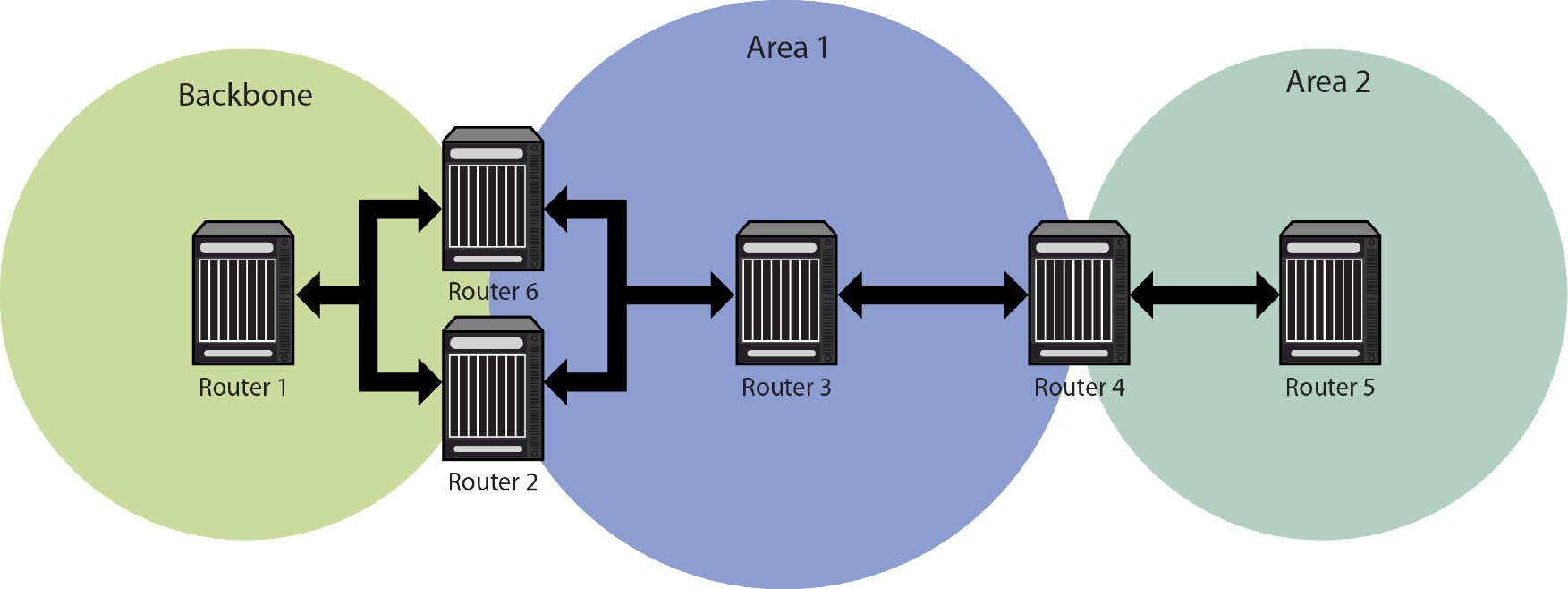A Not So Stubby Area (NSSA) is a hybrid area using an Autonomous System Border Router (ASBR) to connect two disparate organizations. External routes are advertised as Type 7 LSAs and are converted to Type 5 LSAs before flooding to the backbone by the NSSA‘s ABR. Also, summary routes are allowed into the NSSA while external routes from other networks are still filtered from insertion into the NSSA.
External routes that are not imported into an NSSA can be represented by a default route. If the router is an ABR and has the highest router ID of all ABRs in the area, and no other ABR in the area is configured to translate always, it will translate Type 7 LSAs into Type 5 LSAs. Configuring the identity of the translator can be used to bias the routing to aggregated destinations. When translator role is set to Always, Type-7 LSAs are always translated regardless of the translator state of other NSSA border routers.
When a translating ABR loses a translator election, it will stop translating, and after a number of seconds (set by the transstabilityint option), it will flush any Type 5 LSAs resulting from aggregation. Any Type 5 LSAs resulting from direct translation of Type 7 LSAs will be allowed to age out. An ABR will always originate a default route into any attached NSSAs.
If the no-summary option is specified, the ABR does not send type 3 summary LSAs into the NSSA area, therefore all destinations outside of the NSSA area are represented by means of a default route.
Use the area nssa command to configure an area as a Not-So-Stubby-Area.
Routers 2 and 6 are configured as the ABRs between Area 1 and 0, and Router 4 as the ASBR. Router 2 is configured to set Area 1 as an NSSA, and Type 7 routes from the connected domain will be translated to Type 5 routes into the backbone.
ABR Router 2 will only translate Type 7 LSAs; static routes redistributed by router 4. Also, Router 2 will always translate, since it is configured to do so; Router 6 will not, since only one ABR will perform the translation for a given area.
Router 4 will be configured to redistribute static routes.
The following example provides the input required to configure the NSSA topology as displayed in OSPF NSSA Topology:
Router 6(rw)->configure Router 6(rw-config)->interface vlan 1 Router 6(rw-config-intf-vlan.0.1)->ip address 11.1.1.6 255.255.255.252 Router 6(rw-config-intf-vlan.0.1)->no shutdown Router 6(rw-config-intf-vlan.0.1)->exit Router 6(rw-config)->interface vlan 2 Router 6(rw-config-intf-vlan.0.2)->ip address 23.1.1.6 255.255.255.252 Router 6(rw-config-intf-vlan.0.2)->no shutdown Router 6(rw-config-intf-vlan.0.2)->exit Router 6(rw-config)->router ospf 1 Router 6(rw-config-ospf-1)->router-id 6.6.6.6 Router 6(rw-config-ospf-1)->area 1 nssa Router 6(rw-config-ospf-1)->network 11.1.1.0 0.0.0.3 area 0 Router 6(rw-config-ospf-1)->network 23.1.1.0 0.0.0.3 area 1 Router 6(rw-config-ospf-1)->exit
Router 2(rw)->configure Router 2(rw-config)->interface vlan 1 Router 2(rw-config-intf-vlan.0.1)->ip address 11.1.1.2 255.255.255.252 Router 2(rw-config-intf-vlan.0.1)->no shutdown Router 2(rw-config-intf-vlan.0.1)->exit Router 2(rw-config)->interface vlan 2 Router 2(rw-config-intf-vlan.0.2)->ip address 23.1.1.1 255.255.255.252 Router 2(rw-config-intf-vlan.0.2)->no shutdown Router 2(rw-config-intf-vlan.0.2)->exit Router 2(rw-config)->router ospf 1 Router 2(rw-config-ospf-1)->router-id 2.2.2.2 Router 2(rw-config-ospf-1)->network 11.1.1.0 0.0.0.3 area 0 Router 2(rw-config-ospf-1)->network 23.1.1.0 0.0.0.3 area 1 Router 2(rw-config-ospf-1)->area 1 nssa Router 2(rw-config-ospf-1)->area 1 nssa transrole always Router 2(rw-config-ospf-1)->area 1 nssa-range 10.2.0.0 255.255.0.0 Router 2(rw-config-ospf-1)->exit
Router 4(rw)->configure Router 4(rw-config)->interface vlan 2 Router 4(rw-config-intf-vlan.0.1)->ip address 23.1.1.2 255.255.255.252 Router 4(rw-config-intf-vlan.0.1)->no shutdown Router 4(rw-config-intf-vlan.0.1)->exit Router 4(rw-config)->interface vlan 3 Router 4(rw-config-intf-vlan.0.2)->ip address 30.1.1.1 255.255.255.252 Router 4(rw-config-intf-vlan.0.2)->no shutdown Router 4(rw-config-intf-vlan.0.2)->exit Router 4(rw-config)->router ospf 1 Router 4(rw-config-ospf-1)->router-id 4.4.4.4 Router 4(rw-config-ospf-1)->network 23.1.1.0 0.0.0.3 area 1 Router 4(rw-config-ospf-1)->redistribute static metric-type 1 Router 4(rw-config-ospf-1)->exit


 Print
this page
Print
this page Email this topic
Email this topic Feedback
Feedback